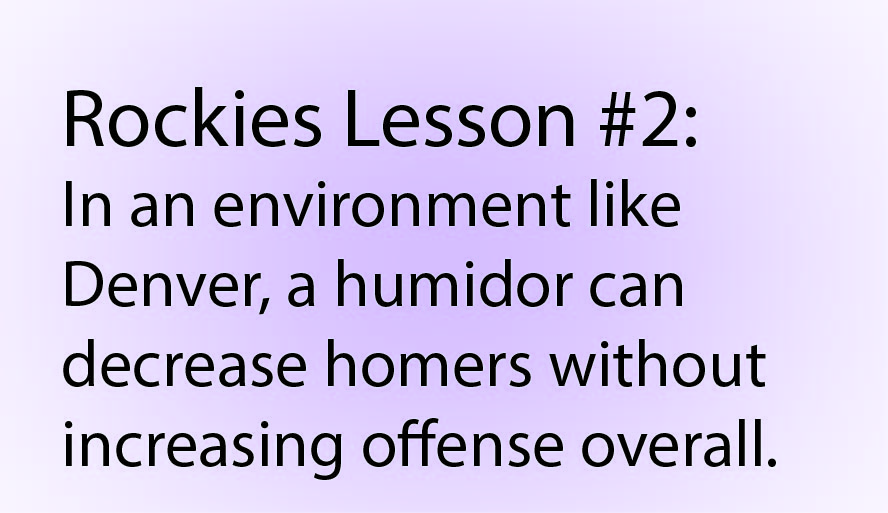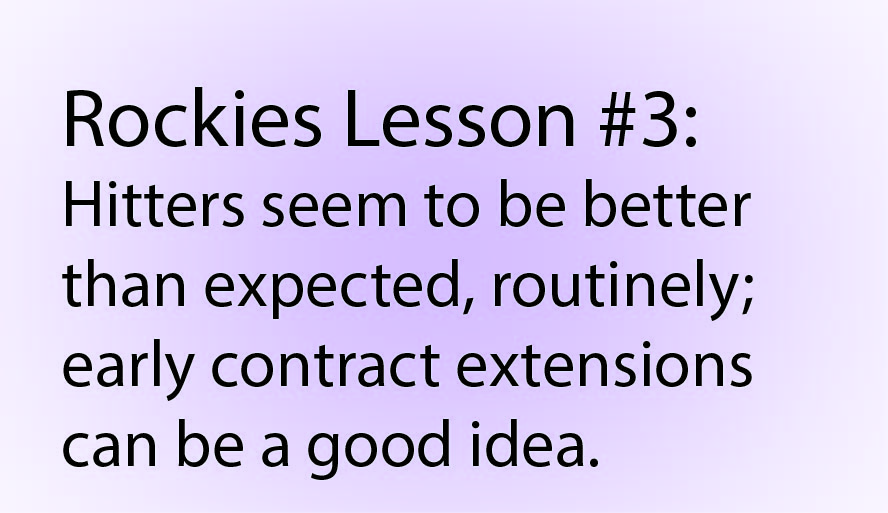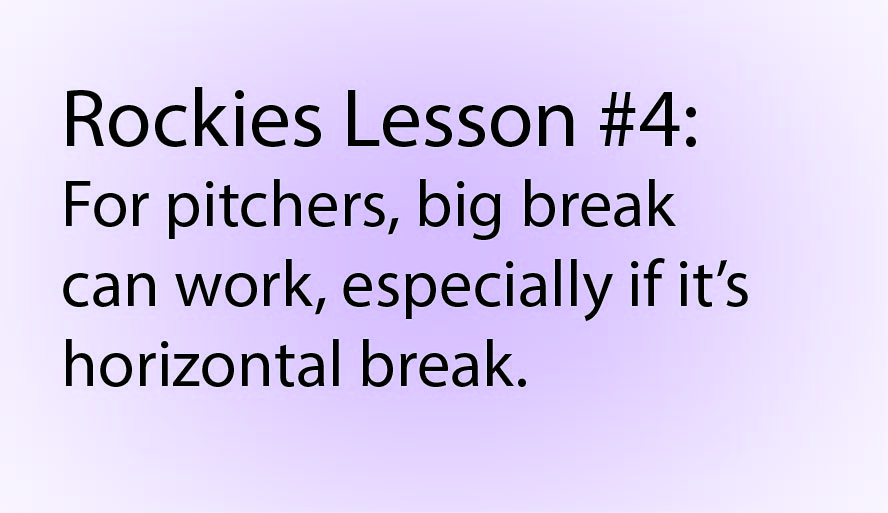What the D-backs Can Learn From the Rockies
Among baseball’s divisions, there’s probably no group of teams with a more diverse collection of venues than the NL West. San Diego has long enjoyed a reputation as baseball’s most pitcher-friendly venue; San Francisco manages to coax an unusual number of triples out of hitters while helping out fly ball pitchers and serving as the platform for baseball’s single-season home run record. The Dodgers play in a fairly vanilla venue, one that famously has no pool. And Coors Field was designed to give us a taste of how baseball would be different if played on the moon.
Mars isn’t a whole lot different than the moon. Chase Field is that odd thing, a park that encourages home runs, other extra base hits and hits overall. Noting recent changes in outfield fences in the last several years, ESPN’s Tristan H. Cockcroft ranked ballparks this year from the hitter-friendliest to pitcher-friendliest, and Chase slotted in right behind Coors, for good reason — but that also meant that the NL West had the top two hitter-friendly parks and the top two pitcher-friendly parks.
Excluding Dodger Stadium, the other NL West parks are all more or less the same age, dating from a time when teams sought charm, uniqueness, and a bead on a strong home field advantage.
But did that work? Baseball’s most eclectic group has tried an admirable number of distinct strategies to win. I think the ways in which NL West teams* have succeeded and failed offer some lessons for the D-backs as they think about recalibrating their retooled run at a championship. Next week, I’ll follow up with some takeaways from the rest of the division — today, let’s look at the team that’s faced challenges most similar to that of the D-backs, the Colorado Rockies.
Lessons From Denver
The Rockies’ home field opened in 1995, three years before Chase — and at the time, it was the first baseball-only park built since Dodger Stadium in 1962. Its designers seemed to have anticipated the effect of thin air on baseball, to some extent, building one of the most expansive outfields the game has seen, before or since. There’s a whopping 97,300 square feet of real estate in the Coors Field outfield, according to research by Andrew Fox before the 2015 season. Only Kauffman Stadium in Kansas City has a larger outfield, and at that point, AT&T Park in San Fran had 5,100 fewer square feet in its outfield. PetCo’s outfield was smaller than Colorado’s by 6,500 square feet.
But that didn’t exactly “work.” Sure, it definitely seems like the team avoided a home run apocalypse that way — but the Rockies deal with the same issue the D-backs deal with, a home park that has a high yield of hits, home runs, and other extra base hits, all at the same time. Depending on how you look at it, the ball travels farther — or just gets where it’s going a lot faster. Combine that with outfielders’ range not growing to match the larger outfield, and you’ve changed the game of baseball.
How have the Rockies dealt with that?
 Most recently, raising some outfield wall. That’s a pretty good approach, if you think about it — you make home runs more difficult without giving your outfielders more real estate to cover. The balls that used to be home runs are still hits, but at least they’re not home runs. We’ve thought about moving in the fences at Chase. But maybe the lesson here is that it makes even more sense to move the fences in if the D-backs also move the fences up.
Most recently, raising some outfield wall. That’s a pretty good approach, if you think about it — you make home runs more difficult without giving your outfielders more real estate to cover. The balls that used to be home runs are still hits, but at least they’re not home runs. We’ve thought about moving in the fences at Chase. But maybe the lesson here is that it makes even more sense to move the fences in if the D-backs also move the fences up.
A related idea: the humidor. A baseball travels farther in thinner air; that’s the Coors Field elevation problem. The fact that Coors is also in the second-driest baseball location actually works in the opposite way; dry air is actually thicker, and the more humid the air, the thinner it is (aFor nd the farther a baseball travels). If you’re trying to discourage hitting, you want air as dry as possible.
But not baseballs. Forget how the baseball travels; focus on what’s traveling. A baseball that’s just been dumped in water isn’t making it over the fence of any park. Baseballs stored in the Coors Field humidor have a 50% humidity; baseballs in Denver not stored in the humidor have a humidity of about 35%. That difference probably doesn’t seem large, but it does mean an average reduction of about 13 feet of distance on every home run ball (and some kind of extra distance on every other batted ball). That’s what Dr. Alan Nathan found with the research, and at the time, the math told him that a humidor should have reduced home runs at Coors by 30% or so (plus or minus 6%), matching fairly closely the actual reduction in home runs after the humidor was installed (25%).
 In the same piece, Dr. Nathan discussed the likely effect of a humidor at Chase Field, finding it would have an even bigger effect: a 45% decrease in home runs, plus or minus 9%. That was based on an estimate of 20% humidity in Phoenix during baseball season, however, and that’s a little high; I’ve discussed this with Dr. Nathan since then, and in his experiments, it’s taken a baseball about three days to reach an equilibrium with the air around it. In the evenings, average humidity is about 20% — but the baseballs are more likely to match the daily average for humidity, which can be more like 15%.
In the same piece, Dr. Nathan discussed the likely effect of a humidor at Chase Field, finding it would have an even bigger effect: a 45% decrease in home runs, plus or minus 9%. That was based on an estimate of 20% humidity in Phoenix during baseball season, however, and that’s a little high; I’ve discussed this with Dr. Nathan since then, and in his experiments, it’s taken a baseball about three days to reach an equilibrium with the air around it. In the evenings, average humidity is about 20% — but the baseballs are more likely to match the daily average for humidity, which can be more like 15%.
I digress. The lesson from Coors Field: a humidor can suppress the number of home runs, if not the number of hits overall (here are some previous notes on how that would work at Chase). That’s a pretty strong takeaway for the D-backs, who haven’t just had pitching problems — they’ve had pitching problems to the point of pitchers not being able to stick in the rotation. Imagine a Rubby De La Rosa or Robbie Ray with less fear of the long ball. That doesn’t just flatten out some pitching problems; it flattens out some roster problems, too. The D-backs would pay an offense price matching the pitching benefit, but they’d get to keep the roster benefits.
 One very predictable consequence of playing so many games in such a hitter-friendly environment: hitters do unexpectedly well. Nolan Arenado came up as a “should hit for average but not power” guy, and now he’s one of the league’s premier power threats. He’s not the first example, and he won’t be the last. Would Todd Helton have been a power hitter in a different environment? We might ask the same of Paul Goldschmidt, a similar hitter in a similar situation. Larry Walker, Carlos Gonzalez, Troy Tulowitzki probably would have hit anywhere. But what about Brad Hawpe, Seth Smith, Dexter Fowler, Garrett Atkins, Chris Iannetta, Jeff Cirillo, Ryan Spilborghs, Ian Stewart, DJ LeMahieu, Clint Barmes, Juan Uribe? Look up Jeromy Burnitz, or Vinny Castilla. Hitters can only do so well, and you don’t want to pay them for Coors Field production — you want to pay them for their minor league promise, or production for some other team. Don’t you think Rockies GM Jeff Bridich is thinking a long term extension offer to Trevor Story would have been nice before the season even began?
One very predictable consequence of playing so many games in such a hitter-friendly environment: hitters do unexpectedly well. Nolan Arenado came up as a “should hit for average but not power” guy, and now he’s one of the league’s premier power threats. He’s not the first example, and he won’t be the last. Would Todd Helton have been a power hitter in a different environment? We might ask the same of Paul Goldschmidt, a similar hitter in a similar situation. Larry Walker, Carlos Gonzalez, Troy Tulowitzki probably would have hit anywhere. But what about Brad Hawpe, Seth Smith, Dexter Fowler, Garrett Atkins, Chris Iannetta, Jeff Cirillo, Ryan Spilborghs, Ian Stewart, DJ LeMahieu, Clint Barmes, Juan Uribe? Look up Jeromy Burnitz, or Vinny Castilla. Hitters can only do so well, and you don’t want to pay them for Coors Field production — you want to pay them for their minor league promise, or production for some other team. Don’t you think Rockies GM Jeff Bridich is thinking a long term extension offer to Trevor Story would have been nice before the season even began?
Most prospects of most teams don’t pan out, and in that context, the D-backs have had extraordinary success with hitters who have made it to the majors. Goldy, David Peralta, Jake Lamb, A.J. Pollock, Ender Inciarte… it’s a long list of hitters who have outperformed expectations by a lot. Luis Gonzalez joined Arizona for his age-31 season, and promptly had OPSes of .952, .935 and 1.117 after an 8+ year career in which he’d topped out at .818. Erubiel Durazo had a couple of nice seasons for the Athletics (at the plate), but flamed out soon after. How did Matt Williams, Junior Spivey, Stephen Drew do with other teams? Like the Rockies, the D-backs shouldn’t pay their own players for Chase Field production. The Paul Goldschmidt contract is a perfect model; the long-term extension with A.J. Pollock that the team didn’t do last winter would have been a mistake. Depending on their profiles, lots of fringe average-ish players will play up at Chase Field, and when that kind of player gets too expensive, it can be time to move on. Lock up the hitters early, or sit on your hands.
 Another Denver nugget: the team’s relentless search for pitching. From anecdotal evidence, I’d contend that in an environment like the Rockies’, big movement on breaking balls is better than tight breaking balls; the Ubaldo Jimenez slider wasn’t exactly a “slurve” because it didn’t break down more than the average slider, but it did feature a ton of horizontal movement. Adam Ottovino has had a ton of success with a similar breaking ball, even if he throws multiple versions of it. That comports with our Zack Greinke observations to date, and if you thought of the Trevor Cahill sinker similarly, you might be more convinced.
Another Denver nugget: the team’s relentless search for pitching. From anecdotal evidence, I’d contend that in an environment like the Rockies’, big movement on breaking balls is better than tight breaking balls; the Ubaldo Jimenez slider wasn’t exactly a “slurve” because it didn’t break down more than the average slider, but it did feature a ton of horizontal movement. Adam Ottovino has had a ton of success with a similar breaking ball, even if he throws multiple versions of it. That comports with our Zack Greinke observations to date, and if you thought of the Trevor Cahill sinker similarly, you might be more convinced.
Finally, from the too little, too late division: the Rockies’ attempt to buy a pitching staff in the 2000-2001 offseason looks a hell of a lot like the D-backs’ effort this last winter. Mike Hampton had been a near-ace for much of his early career, but enjoyed two particularly excellent seasons in 1999 and 2000, looking a lot like a FIP-beater and ace-level contact manager; he was awarded the largest sports contract in history at that time, an 8-year, $121 million deal. Denny Neagle got a five-year deal of his own at the same time worth more than $50M, after establishing himself in the majors as a strikeout pitcher with the  Pirates and reinventing himself as more of a 3.00-ERA contact management type with the Braves. Does that sound familiar? Both pitchers never had a season with the Rockies with an ERA under 5.00. Since then, the Rockies’ experience with that pair of pitchers has been held out as a lesson that buying pitchers who were decent elsewhere is not a great strategy for Denver.
Pirates and reinventing himself as more of a 3.00-ERA contact management type with the Braves. Does that sound familiar? Both pitchers never had a season with the Rockies with an ERA under 5.00. Since then, the Rockies’ experience with that pair of pitchers has been held out as a lesson that buying pitchers who were decent elsewhere is not a great strategy for Denver.
You get the idea. It’s already looked this year (especially after experiments last year) like contact management doesn’t work in Arizona as a pitching style. Greinke could prove the exception to the Hampton/Neagle Rule, but he could also end up like Hampton, with a contract eventually shouldered by three teams. Fingers crossed that Shelby Miller isn’t Neagle.
3 Responses to What the D-backs Can Learn From the Rockies
Leave a Reply Cancel reply
Recent Posts
@ryanpmorrison
 Congrats to @OutfieldGrass24 on a beautiful life, wedding and wife. He deserves all of it (they both do). And I cou… https://t.co/JzJtQ7TgdJ, Jul 23
Congrats to @OutfieldGrass24 on a beautiful life, wedding and wife. He deserves all of it (they both do). And I cou… https://t.co/JzJtQ7TgdJ, Jul 23 Best part of Peralta’s 108 mph fliner over the fence, IMHO: that he got that much leverage despite scooping it out… https://t.co/ivBrl76adF, Apr 08
Best part of Peralta’s 108 mph fliner over the fence, IMHO: that he got that much leverage despite scooping it out… https://t.co/ivBrl76adF, Apr 08 RT @OutfieldGrass24: If you're bored of watching Patrick Corbin get dudes out, you can check out my latest for @TheAthleticAZ. https://t.co/k1DymgY7zO, Apr 04
RT @OutfieldGrass24: If you're bored of watching Patrick Corbin get dudes out, you can check out my latest for @TheAthleticAZ. https://t.co/k1DymgY7zO, Apr 04 Of course, they may have overtaken the league lead for outs on the bases just now, also...
But in 2017, Arizona ha… https://t.co/38MBrr2D4b, Apr 04
Of course, they may have overtaken the league lead for outs on the bases just now, also...
But in 2017, Arizona ha… https://t.co/38MBrr2D4b, Apr 04 Prior to the games today, there had only been 5 steals of 3rd this season (and no CS) in the National League. The… https://t.co/gVVL84vPQ5, Apr 04
Prior to the games today, there had only been 5 steals of 3rd this season (and no CS) in the National League. The… https://t.co/gVVL84vPQ5, Apr 04
Powered by: Web Designers@outfieldgrass24
 RT @kileymcd: Source: D'Backs are calling up Daulton Varsho. Son of former MLBer Gary, Top 100 prospect, plus runner with plus co… https://t.co/QHPGqGB7cY, 46 mins ago
RT @kileymcd: Source: D'Backs are calling up Daulton Varsho. Son of former MLBer Gary, Top 100 prospect, plus runner with plus co… https://t.co/QHPGqGB7cY, 46 mins ago RT @Kazuto_Yamazaki: https://t.co/9jtcri4Kp0, 2 hours ago
RT @Kazuto_Yamazaki: https://t.co/9jtcri4Kp0, 2 hours ago Welcome to The VarShow https://t.co/tLlO8AAA7T, 54 mins ago
Welcome to The VarShow https://t.co/tLlO8AAA7T, 54 mins ago Nick Madrigal coming up makes it a great day to be a Beaver #GoBeavs, 3 hours ago
Nick Madrigal coming up makes it a great day to be a Beaver #GoBeavs, 3 hours ago
Powered by: Web Designers





Good stuff, hope Stew reads it!
[…] for the Diamondbacks than the group closest to home: the NL West. Last week, we looked for some takeaways from the Rockies’ experiences, as they are the team most similar to the D-backs. For slightly different reasons, the ball flies […]
[…] couple weeks back, we looked for some takeaways from the Rockies’ experiences, since they’re the team in the situation most similar to that of the D-backs. And last week, […]